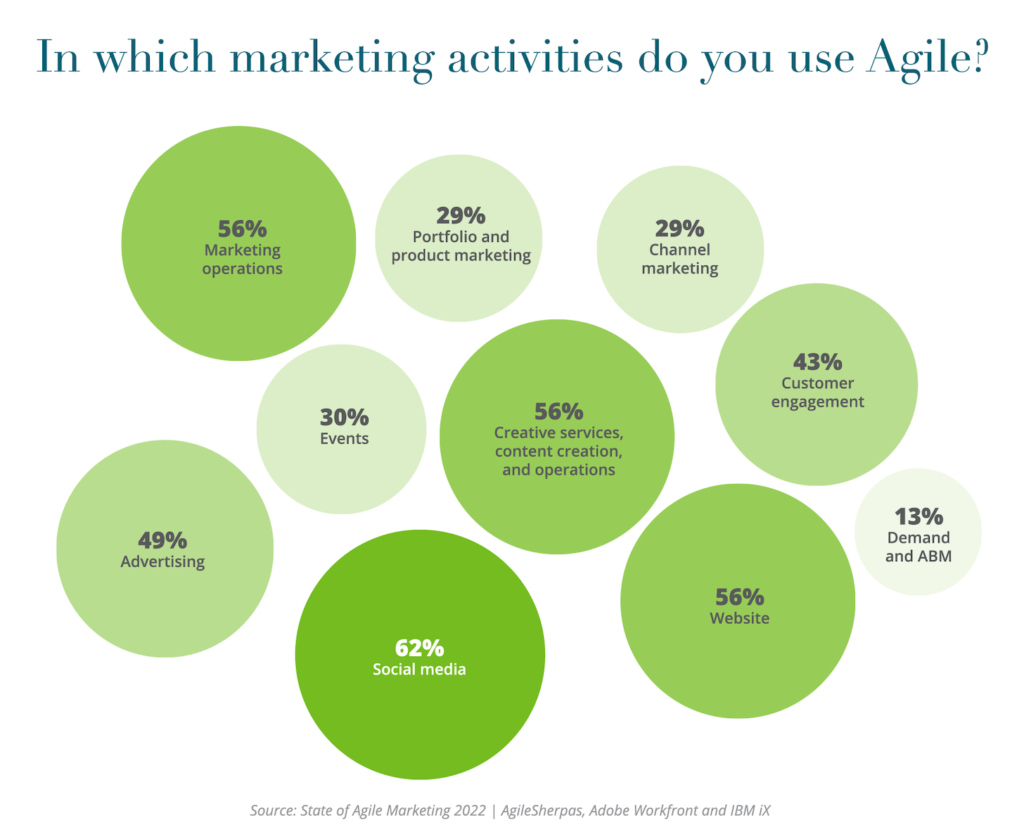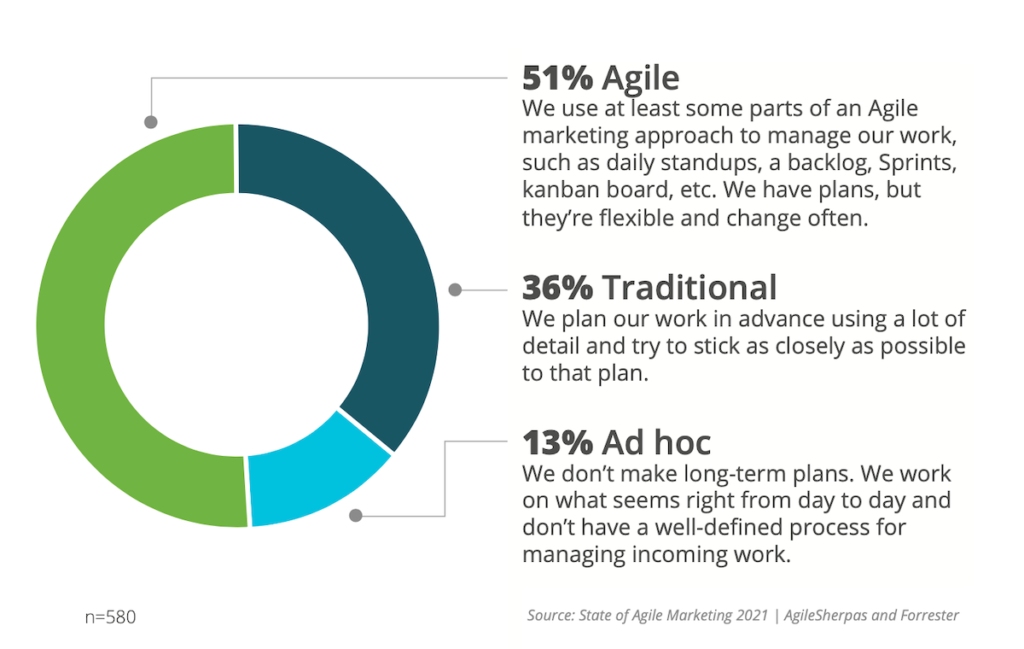
Agile marketing has been gaining a lot of steam over the past year, but we’re still in the “early adopter” stage of this movement.
(If you have no idea what agile marketing is, I recently posted a video introduction to agile marketing as well as an essay version.)
Most teams that have adopted agile marketing have had to figure it out on their own, improvising from ideas of agile development and adapting the process as they go along. There are precious few published stories of how real teams have struggled through that process that others could use as a reference and inspiration.
So I was thrilled when David Quinn and Amy Callahan of EMC agreed to share their pioneering experiences with adopting agile marketing in the following Q&A:
To start, can you tell us a little bit about each of your backgrounds and your roles at EMC?

David Quinn, Senior Director, Corporate Marketing Engagement Office
I’ve led a variety of marketing functions for EMC in both web marketing and marketing support. Currently leading the Engagement Office within the corporate marketing organization as we define, deploy and refine new methodologies for success within the marketing organization.
Amy Callahan, Senior Engagement Manager, Corporate Marketing Engagement Office

Coming from a high-tech, account management background, I joined EMC seven years ago, holding various positions throughout web marketing. I volunteered to help build out the “agile pilot” two years ago, which led to my current role as a senior engagement manager.
What motivated you to embrace agile marketing in the corporate marketing team? Where did the inspiration come from?
It was not really a case of “deciding” to utilize agile marketing, but rather a result of addressing real business problems we faced within the corporate marketing organization.
We had been battling a set of parallel issues while trying to take on the vast amounts of work that come into the CM organization. On one hand, the corporate marketing groups were overwhelmed with requests, actions and deliverables that were thrust upon them on a daily basis. With no particular prioritization or synchronization it was difficult to know which activities were critical and which could be addressed later. Also, each group made priority decisions in a vacuum.
With no particular prioritization or synchronization it was difficult to know which activities were critical and which could be addressed later.
At the same time, business owners — those people and groups who needed the corporate marketing teams’ services — were knocking on the doors of the CM teams, telling their story and asking for help — sometimes several times over — as they attempted to cover all the requisite functions.
Needless to say, not everyone heard the same things and, as noted, not everyone prioritized the work in the same fashion. In addition, it was often the case that a business owner simply did not think about a particular area of corporate marketing that could bring value to their project, and therefore certain areas were overlooked.
It was then that our new Senior VP of Corporate Marketing, Jonathan Martin, recognized the need for change. He asked us to look at the problem and consider some radical solutions to the way we conducted our business — inclusive of the agile concepts that we were somewhat familiar with from our prior web experience around software development.
How did you get started? What were some of the challenges you faced in adopting an agile approach, and how did you overcome them?
Because this was uncharted territory and there was no Engagement Office or Engagement function in existence, I looked around my existing organization and asked for volunteers who were looking for a challenge. Fortunately, several people raised their hands and decided that a second job, in addition to their current one, seemed like a good idea. Truthfully, these folks saw an opportunity to solve a real business problem and work on something that was truly cutting edge.
This mini team met daily for a number of hours and took the time to diagnose the real issues. While we really wanted to dig into our effort of “marketizing” the agile development process, the team recognized the gravity of introducing major change into our current environment — therefore sound research needed to proceed action.
Rather than move forward with a new set of ideas, we initially worked with each functional group within CM to get their perspective on the issues at hand. We did the same thing with other parts of the business that were looking to the CM organization for help. It was literally a case of documenting the pain points and presenting it back to the various constituencies to make sure we had captured their thoughts and issues.
In true agile form, we applied a process framework and iterative plan but recognized that we needed to be flexible: try it, learn from it, and adjust as necessary.
Once we completed that effort we began to build a process that incorporated agile methodologies seen in the development world and applied those to the problem at hand. Then it was time to jump in with both feet and give it a try. We picked one existing campaign effort and built a pilot team around those activities as our first real “engagement.” In true agile form, we applied a process framework and iterative plan but recognized that we needed to be flexible — that is, try it, learn from it, and adjust as necessary.
The initial challenges within the pilot, once we scaled the program, were very much the same. The frequency of meetings, albeit only 15 minutes in duration, were frustrating for some of the subject matter experts. The role of Engagement Manager was initially confusing to some, as it was not a typical project manager role, but rather an effort to facilitate and enable a true team atmosphere and effort.
In the end, we can sum up the biggest challenge in one simple word: change. Change is hard, change is uncomfortable and change is typically met with resistance. The initial feedback was not overly positive and not all parties were embracing this new methodology.
We can sum up the biggest challenge in one simple word: change. Change is hard, change is uncomfortable and change is typically met with resistance.
In time, we did overcome the resistance, the backlash, and the frustrations. We were successful for two reasons. We did our homework. We never decided for others what their problems were. We let them define the issues. And when we began to utilize the agile methods, we were able to point back to specific pain points and show just how the new methods addressed those particular issues.
Additionally, our team fully bought into the lean agile concepts. We built out a full process by spending many hours reviewing results and commentary, adapting those thoughts by refining our process, and creating more predictable outcomes.
What are the different roles and responsibilities in your agile marketing teams?
In each engagement there are three types of roles:
1. The Business Owner is in effect any individual or group that comes forward with a project or request that requires the services of multiple corporate marketing functions. They can come from any part of the company with a wide variety of asks, from product launches to campaigns to marketing programs. The Business Owner participates in all the activities throughout the agile process.
2. The Engagement Manager is responsible for driving and enabling the team on a particular project or effort. They function as a front door to marketing and work much like an agency to pull together a virtual team based on the needs of a particular project. They have been trained to advocate for all Corporate Marketing functions so they can offer the Business Owner (the requestor) advice on what groups should be “at the table.” They drive the engagement throughout and pull together all relevant meetings while not inhibiting the one-on-one collaboration between key stakeholders.
3. The Subject Matter Experts (SMEs) make up the third portion of the team. Each relevant functional team assigns a representative to each engagement to represent that team throughout the effort. As part of the engagement effort they are now able to be at the table earlier and concentrate on proactive consultation versus reactive fire drills.
Can you walk us through the process — what are the steps of an agile marketing project with your group?
In its simplest form, the engagement steps consist of:
- A business request
- Business Objectives Meeting
- Iterative Planning Meeting
- Sprint Sets
- Launch
- Demonstration
- Retrospective
The Engagement Manager meets with the requestor to define the marketing backlog and pulls together the key players so that all members hear the same story at the same time. This provides the opportunity for all members of the virtual team to comment and collaborate on additional ideas.
Sprint sets are defined, and the cadence for stand-up meetings is agreed upon and the process begins. It results in continuous output that depletes the existing backlog and allows for ongoing prioritization.
Finally, mandatory demonstration and retrospective meetings provide everyone the chance to see the greater results and to reflect on the engagement as a whole. Valuable insights are brought back to the Engagement Office and fed back into the process as appropriate.
Can you share with us one or two examples of the kinds of projects that have been successful with agile marketing?
Our plan for launching new products has been completely refined using the agile methodology. We built an agile “recipe” for each launch tier that provides teams a track to run on, making the entire effort simpler and completely transparent, while allowing for the subtle changes necessary in each launch effort.
This lean approach has helped to support what we believe is critical thinking: do fewer things better.
Our campaign activities have all gone through the process and have been very successful. The sheer volume of assets and activities associated with each campaign have benefited from the new model. Constant prioritization and the ability to plan activities and deliverables throughout the year has been rewarding to all involved. This lean approach has helped to support what we believe is critical thinking: “Do fewer things better.”
Looking back, what would you say have been the greatest benefits of agile marketing?
The ability to focus and prioritize for the CM Groups — they know how to schedule work based on the overall needs and each group understands the bigger picture without guessing.
Time management. The Business Owners don’t spend days trying to get around to each functional group to present their ask. And while all team members balked initially at the idea of regular stand up meetings, they eventually agreed that frequent short meetings eliminate the need for many long drawn out meetings with various groups trying to get in line with the activities of the others.
The “corporate nod” is just not going fly during a stand-up meeting when you’re on the hook for a deliverable that other team members are waiting on.
Accountability through transparency. Great teams establish good ground rules. It’s easier to challenge people when these rules are well known. A good Engagement Manager can make visible the differences to achieve alignment. The “corporate nod” is just not going fly during a stand-up meeting when you’re on the hook for a deliverable that other team members are waiting on to start their processes. This type of interaction becomes so important, especially in today’s global/remote team world.
If you could offer one key piece of advice to CMOs who are considering adopting agile marketing, what would you tell them?
We would like to offer two:
1. Agile Marketing teams need to act in a manner like their name. There is no one process or solution that is “right.” What works for one company or organization is not necessarily the perfect recipe for another. Be flexible, try it out, and be ready to change. Assume you will have to re-craft your effort and reorganize your process. But don’t be afraid to try it and fail — just take the learnings and apply them quickly. The world will not come to an end. Be agile yourself.
Don’t be afraid to try it and fail — just take the learnings and apply them quickly. Be agile yourself.
2. Understand from the beginning that change is hard. No one wants to change the way they do things. It’s not comfortable. It’s scary. It’s threatening. Understand all of these things. Your teams will feel this way and they will react. That said, if you understand it and show them — versus forcing them — that the change actually benefits them in specific areas they have identified as problems or difficult tasks, they will embrace the change.
Thank you, David and Amy!



Hi Scott, this is a great article. Thanks for being a visionary and sharing with all of us!
You’re welcome — although the credit for being visionary goes to EMC!
Great information for many people who are interested in adopting Agile marketing, but aren’t really sure what they’re getting in to. Thanks!
How is agile marketing different than what startup marketers do every day? Feel like I’ve been doing agile marketing for years but didn’t know it?